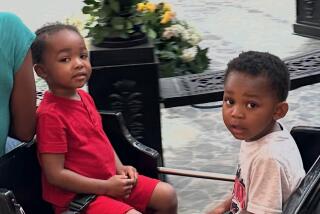A Second Miracle Bonds Twins’ Family
The homesick parents of formerly conjoined twins were disappointed when doctors at UCLA abruptly postponed their return to Guatemala last month. But nurses and social workers said this week that the time in the hospital has brought about something almost as amazing as the surgical feat of separation.
Amid the fluorescent lights and clicking machines of the pediatric ward, the twins and their parents, who had not lived together before June, have become a close-knit family.
“They have come into their own as parents,” said social worker Nancy Hall. “I don’t know how they’ve done it. I’m used to this country, and I speak English, and I don’t know that I could have done as good a job.”
Maria de Jesus and Maria Teresa Quiej Alvarez, 16 months old, arrived in Los Angeles in June with their mother, Alba Leticia Alvarez, 22. Their skulls were fused at the top of the head, their bright brown eyes facing opposite directions. They had spent most of their lives in a Guatemala City hospital, and their parents had been able to visit them only a few times a month, after an arduous five-hour bus ride from their village.
In August, a team of UCLA surgeons took Las Maritas, as they are known in Guatemala, into the operating room for a marathon 22-hour separation.
The surgery, donated by UCLA and costing more than $1.5 million, drew worldwide attention. It prompted prayer vigils across Guatemala and sent the media stampeding to the doorstep of the overwhelmed parents, who social workers say were already suffering from culture shock.
After the separation, the girls improved slowly. They stopped reaching their little hands over their heads searching for each other and began to take delight in looking into each other’s eyes.
The connection between the girls stuns their nurses. When Maria Teresa, who has been slower to recover than her sister, is not feeling well, Maria de Jesus will refuse to eat too. Each girl is also keenly aware of how much attention the other receives, and if one seems to get more than her share, the other will make her displeasure known, nurses said.
They are endlessly fascinated by each other’s faces. One day, nurse Margo Goldman walked over to Maria Teresa with the other twin in her arms. The girls stared at each other for more than 10 minutes, Goldman said, while she barely breathed. Then Maria de Jesus’ face burst into a grin and she laughed in delight.
“They are amazing girls,” Goldman said. “They give so much love, it’s unbelievable.”
Michaela Franco, a nurse who has cared for the girls since they arrived, said this is why she became a nurse.
“When we were told we were going to admit Guatemalan conjoined twins, we did not expect to have two clever, beautiful ... vibrant separate beings with poignantly distinct personalities,” she said.
On Sept. 27, Maria de Jesus moved from the intensive care unit to a room on the pediatric floor. Her sister followed shortly after, and their parents left a relatives’ house in Culver City and moved into the girls’ room.
That’s when the second miracle occurred, nurses and social workers say.
Until this fall, Alvarez had never consistently diapered her babies or fed them. The girls were more accustomed to the hospital workers in Guatemala, who were their day-to-day caregivers. It was the same with their father, Wenceslao Quiej Lopez, 21.
All that has changed.
Maria de Jesus typically wakes first, nurses said, and her father is right there with her. More outgoing than his wife, he is trying to learn English, and practices it with Maria de Jesus as he puts her in her high chair and gives her a bottle.
“Good morning,” he says. “Not cry ... OK?”
De Jesus, as her nurses call her, usually responds with a giggle. Before the separation, she was the smaller and quieter of the twins, but she has blossomed into an extroverted toddler who loves imitating others’ expressions and reaching out to grab their noses.
After breakfast, the parents bathe their girls together and then dress them from an array of freshly laundered dresses.
Their days then pass in a blur of physical and occupational therapy.
The girls have a tendency to tilt their heads because their muscles and bones had grown that way. In part, this caused the delay in their homecoming. Maria de Jesus’ tendency to sleep on one side put pressure on the skin graft on her head and prevented it from healing. In the last few weeks, she has been given special cushions, has had her head repositioned while she sleeps and has been treated with a growth factor to accelerate healing.
Recently, doctors also have discovered that Maria Teresa has suffered hearing loss in one ear, perhaps as a result of the surgery.
They caution that both girls still face significant rehabilitation back home in Guatemala.
But a new life awaits them there. In the works are a possible new job for their father, a donated apartment in Guatemala City and a new house in Belen, their impoverished hometown on the country’s south coast.
Today, the family will mark Thanksgiving in the pediatric ward.
Plastic surgeon Henry Kawamoto said the family “should reach Guatemala in plenty of time to hear their relatives sing, ‘Feliz Navidad.’ ”
More to Read
Sign up for Essential California
The most important California stories and recommendations in your inbox every morning.
You may occasionally receive promotional content from the Los Angeles Times.










